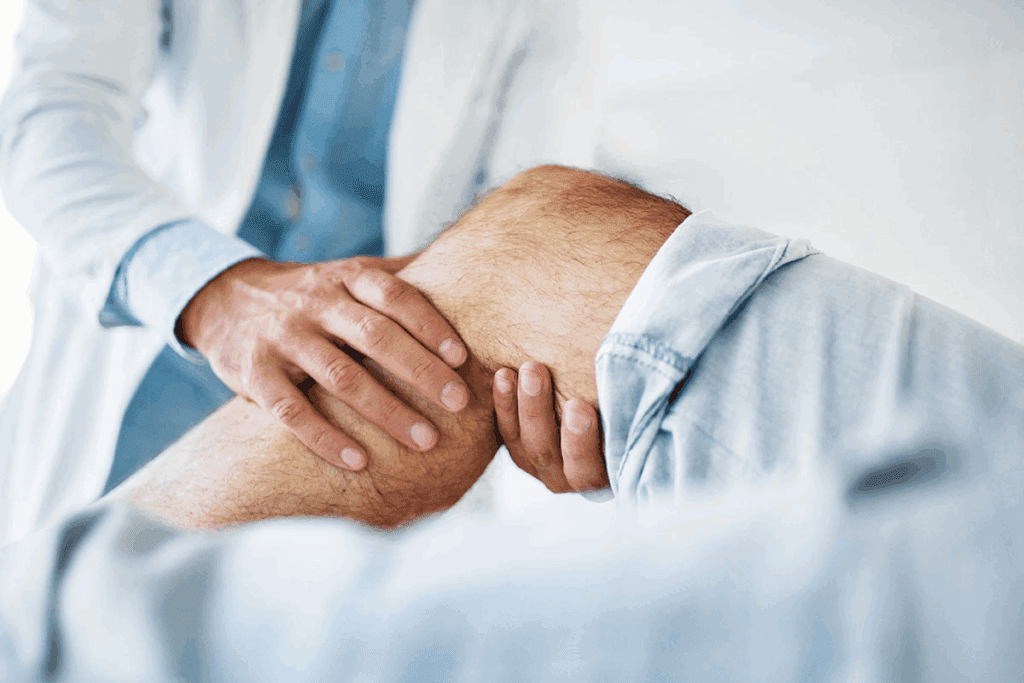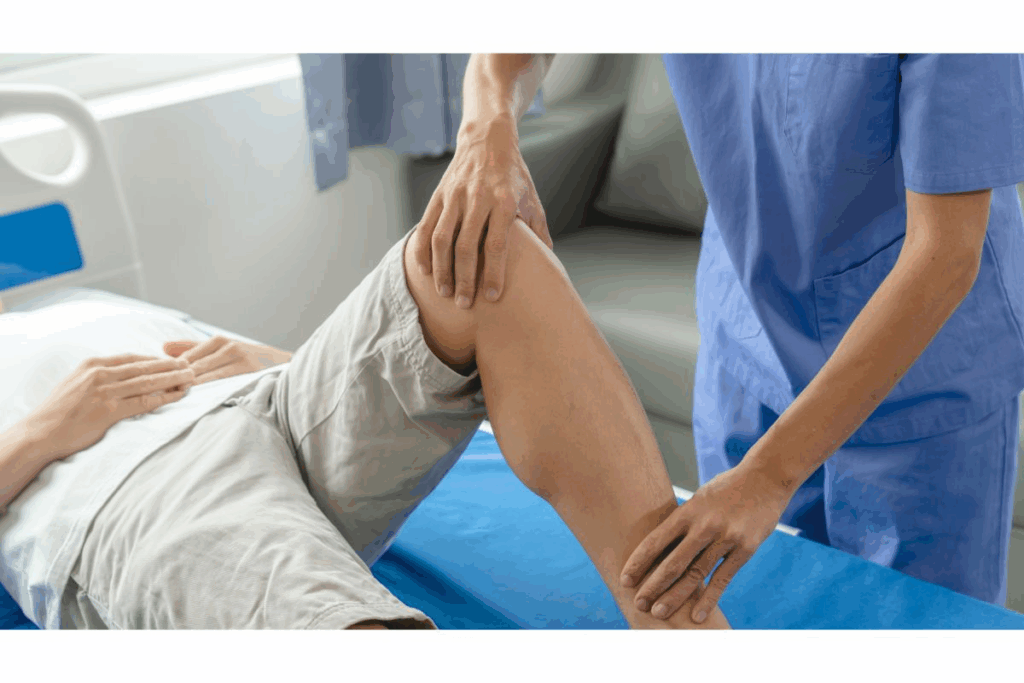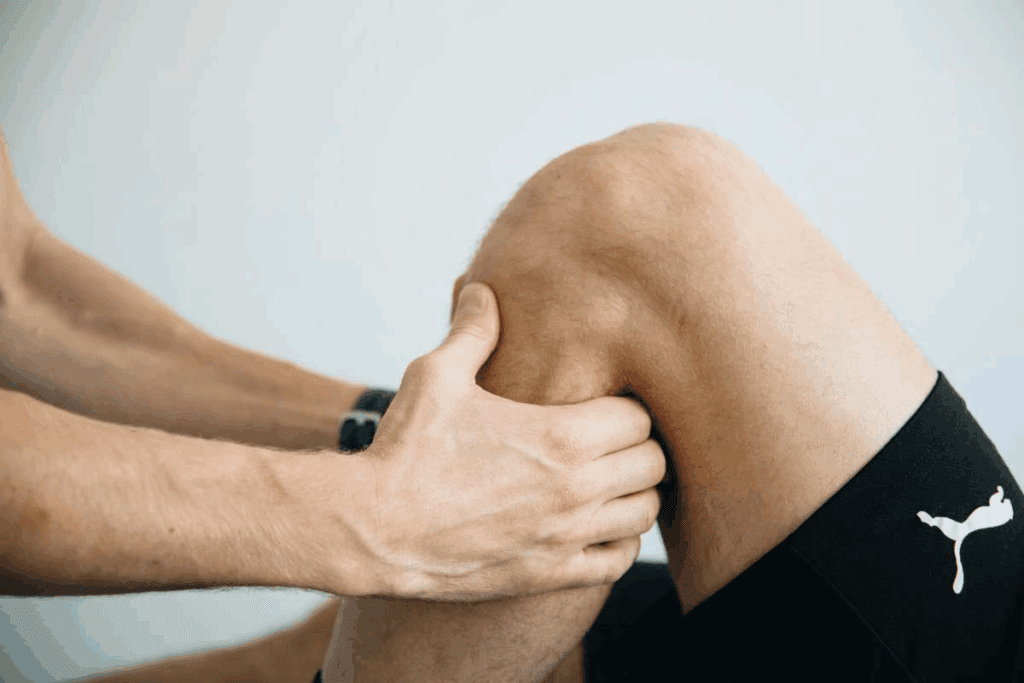Last Updated on November 4, 2025 by mcelik

Knee pain is a significant global health issue affecting millions. But when does it usually start? Studies show that knee pain gets worse with age. It affects a lot of people, mostly older adults, with the average age knee pain typically beginning in middle to older adulthood.
Knee problems can come from many sources. These include wear and tear, injuries, or health issues. As we get older, the chance of knee pain goes up. This makes it a big worry for middle-aged and elderly folks.

We start by exploring the knee joint’s anatomy to comprehend the sources of knee pain. Knee pain is a widespread issue affecting people of all ages. Understanding its basics is key to effective management and treatment.
The knee joint is a complex structure. It consists of bones, ligaments, tendons, and cartilage. The femur (thigh bone), tibia (shin bone), and patella (kneecap) form the joint. Ligaments and muscles help with stability and movement.
The health of these components is vital for normal knee function. Issues like ligament sprains, meniscal tears, or cartilage degeneration can cause knee pain.
Knee pain can significantly impact daily life. Simple tasks like walking, climbing stairs, or even standing for extended periods can become painful and difficult.
| Activity | Impact of Knee Pain |
| Walking | Reduced distance and speed due to pain |
| Climbing Stairs | Increased pain when ascending or descending |
| Standing | Difficulty standing for long periods |
Understanding the anatomy of the knee and how knee pain affects daily activities is essential. By recognizing the causes and impacts of knee pain, we can better navigate knee pain treatment options and management strategies.

Knee pain affects people differently based on their age. This is seen in both global and U.S. data. Knowing these trends helps in preventing and treating knee pain.
Globally, knee pain is widespread. Studies show that:
In the U.S., knee pain trends with age. Important facts are:
These numbers highlight the need for age-focused knee pain management. Healthcare professionals can better help by understanding how knee pain varies by age.
Knee pain in young people is a growing concern. It can come from many sources, like growth issues, sports injuries, and health problems. Knowing why it happens helps find the right treatment.
Knee pain in kids and teens often comes from growing too fast. Osgood-Schlatter disease is a common cause. It makes the knee hurt and swell, mainly in young athletes.
Knee pain can also come from sports. Running, jumping, and quick turns can hurt ligaments and menisci. It’s important to train right, wear the right gear, and have good supervision.
Treatment for knee pain in kids and teens varies by cause. For growth issues, rest, ice, and physical therapy are often used. Sports injuries might need more, like bracing and surgery.
Here’s a quick guide to common causes and treatments for knee pain in kids and teens:
| Cause | Treatment Approach |
| Growth-Related Conditions (e.g., Osgood-Schlatter disease) | Conservative management (RICE, physical therapy) |
| Sports-Related Injuries (e.g., ligament sprains, meniscal tears) | Bracing, rehabilitation, and possible surgery |
Early diagnosis and proper treatment are key. They help kids stay active and healthy.
Knee pain is common in young adults due to athletic injuries and overuse. This age group is often very active, doing sports and activities that stress the knee. Knee pain can affect their quality and sports performance.
Young adults often get knee pain from sports injuries. These can be sudden, like sprains or tears, or from doing the same thing over and over, like tendinitis. Activities like running or cycling can cause knee pain.
Doing the same thing too much can lead to knee pain in young adults. Conditions like PFPS and IT band syndrome are common. These can make it hard to move and need special care.
It’s important to act fast when knee pain starts in young adults. This can mean physical therapy, using braces, or changing how much you do. Strengthening muscles, improving flexibility, and knowing where your body is helps a lot.
Here are some ways to start early:
The table below shows how to start early with knee pain in young adults:
| Intervention Strategy | Description | Benefits |
| Strengthening Exercises | Targeting quadriceps, hamstrings, and hip stabilizers | Improved knee stability and reduced pain |
| Flexibility and Stretching | Enhancing range of motion and reducing stiffness | Better mobility and reduced risk of further injury |
| Proprioceptive Training | Improving neuromuscular control and awareness | Enhanced athletic performance and injury prevention |
Using these early steps can help young adults manage knee pain. They can stay active and avoid more injuries.
Knee pain becomes common in the 40s and 50s. It’s caused by lifestyle choices and degenerative changes. We’ll look at these factors and how to keep knees healthy during this time.
In middle age, the knee joint starts to wear down. This leads to pain and stiffness. The main changes are:
For middle-aged adults, it’s important to balance activity and knee protection. Regular, low-impact exercise keeps joints mobile and muscles strong. Avoiding high-impact activities helps prevent further damage.
Here are some key strategies:
By following these strategies, middle-aged adults can manage knee pain and maintain their quality of life. It’s about making informed choices that support knee health while staying active.
Knee pain is a significant global health issue affecting millions.
Osteoarthritis is a common cause of knee pain in older adults. It happens when cartilage breaks down, causing bones to rub together and hurt. Other conditions like rheumatoid arthritis, gout, and meniscus tears also cause knee pain.
These conditions not only cause pain but also affect the knee’s function. This makes everyday tasks hard.
It’s important for older adults to stay mobile. This helps them do daily tasks and stay independent. Ways to manage knee pain and stay mobile include:
By using these methods, older adults can improve their quality of life. They can reduce knee pain and stay mobile.
Knee pain can come from injuries, degenerative conditions, and inflammatory disorders. We’ll look at these causes to understand knee pain across different ages.
Traumatic injuries are a big reason for knee pain, mainly in younger people. These injuries happen from sports, accidents, or sudden twists. Common injuries include ligament sprains, meniscal tears, and fractures.
ACL injuries are common in athletes who stop and change direction quickly. Symptoms include sudden pain, swelling, and feeling unstable. Getting medical help right away is key to treating these injuries.
Degenerative conditions cause knee pain, mostly in older adults. Osteoarthritis (OA) is the most common type, in which cartilage breaks down. This leads to pain, stiffness, and less mobility.
Other conditions like osteochondritis dissecans and chondromalacia patellae also affect the knee. Treatment often includes lifestyle changes, physical therapy, and medicine to ease symptoms and slow the disease.
Inflammatory and autoimmune disorders can also cause knee pain. Conditions like rheumatoid arthritis (RA) and gout cause inflammation and pain. RA is a chronic autoimmune disorder that can severely affect the knees if not managed.
Treating these conditions involves medicines like DMARDs and biologic agents. Anti-inflammatory drugs and corticosteroid injections also help manage symptoms.
Knowing the average age for knee surgery helps us understand how common it is. It shows us the different types of surgeries, like arthroscopic and total knee replacements. Each has its own age trends.
Arthroscopic surgeries are used to find and fix knee problems. They are popular among young athletes and older adults with knee issues.
The age for these surgeries varies. But it’s usually lower than for more serious surgeries. People getting arthroscopic procedures are often between 30 to 50 years old.
Partial knee replacements are for those with damage in just one part of the knee. This surgery is less invasive and has quicker recovery times.
The average age for this surgery is about 60 years. But it can change based on the patient’s health and the extent of damage.
Total knee arthroplasty (TKA) is when the whole knee joint is replaced. It’s common in older adults with severe osteoarthritis or other knee problems.
| Age Group | Percentage Undergoing TKA |
| 50-59 years | 15% |
| 60-69 years | 40% |
| 70-79 years | 30% |
| 80+ years | 15% |
The average age for TKA is usually 65 to 70 years. This shows how common it is for older adults to need this surgery.
In conclusion, the age for knee surgery varies a lot depending on the type. Knowing this helps doctors plan better for different age groups.
The link between gender and knee pain is complex. It’s shaped by hormones, body structure, and lifestyle. Knowing these differences is key to treating knee pain effectively.
Studies show that men and women experience knee pain in different ways. Women often face knee pain more, which is more common with age. This highlights the need to find out why.
Hormones play a big role in joint health, more so for women. Changes in estrogen levels can affect how stable joints are. This can lead to more knee pain.
Body structure also affects knee pain differently for men and women. Women’s wider pelvis and greater Q-angle can put more stress on the knee.
Understanding these gender differences helps us tailor treatments better. This can lead to better outcomes for those with knee pain.
Knowing how lifestyle affects knee health is key to avoiding early knee pain. Our daily habits, like body weight, exercise, and work, greatly influence when we might feel knee pain.
Keeping a healthy weight is vital for knee health. Extra weight increases stress on the knee, speeding up wear and tear. Studies show that each pound of extra weight multiplies knee stress several times when moving.
So, controlling obesity through diet and exercise can help delay knee pain.
Body Mass Index (BMI) and Knee Pain Correlation
| BMI Category | Risk Level for Knee Pain | Average Onset Age |
| Underweight (<18.5) | Low | 55+ |
| Normal (18.5-24.9) | Moderate | 50-60 |
| Overweight (25-29.9) | High | 45-55 |
| Obese (>30) | Very High | <45 |
Regular exercise keeps knees healthy. But the kind and how hard you exercise matter. High-impact sports are good for the heart but can harm knees if not balanced with gentle exercises and rest.
Recommended Exercises for Knee Health
Jobs that involve a lot of knee bending, heavy lifting, or standing can harm knees. Knowing these risks helps prevent knee pain.
By understanding these lifestyle factors and making smart choices, we can protect our knees. This can help delay knee pain.
Treating knee pain depends on the patient’s age and the cause of pain. Different ages and conditions need different treatments. It’s important to tailor management strategies for each case.
Conservative management is often the first step for knee pain. It includes physical therapy, lifestyle changes, and assistive devices. Younger patients might focus on strengthening muscles and improving flexibility.
Older adults might need to manage their weight and use canes or walkers. This reduces stress on the knee joint.
“Conservative management is key for improving life quality in patients with knee pain,” says an orthopedic specialist. “A multi-faceted approach helps address pain causes, improving mobility and comfort.”
When conservative methods fail, medication is needed. The right medication depends on age, condition severity, and health. Younger patients might get anti-inflammatory drugs for pain and inflammation.
Older adults might need more medications for chronic conditions like osteoarthritis.
Regenerative medicine offers new hope for knee pain treatment. Treatments like PRP therapy and stem cell therapy aim to repair damaged tissues. They promote healing in the knee joint.
Regenerative therapies are becoming more popular. They offer long-term relief and might avoid surgery. These treatments are a big step forward in managing knee pain for all ages.
Managing knee pain needs a mix of exercises to strengthen and flex the knee. These exercises help by making the muscles around the knee stronger and more flexible. This reduces the pressure on the knee joint.
It’s key to strengthen the muscles around the knee for support and stability. Some good exercises include:
Do these exercises in sets of 10-15 reps. Increase as your strength grows.
Keeping the knee flexible and moving well is also key. Good exercises for this are:
Do these exercises gently to avoid straining the knee further.
Low-impact cardio keeps you fit without hurting your knees. Good options are:
As noted by The Arthritis Foundation
“Exercise is a critical component of managing knee pain, providing benefits from improved strength to enhanced flexibility.”
| Exercise Type | Examples | Benefits |
| Strengthening | Quad Sets, Straight Leg Raises | Improved muscle support around the knee |
| Flexibility | Knee Bends, Heel Slides | Enhanced range of motion |
| Cardiovascular | Swimming, Cycling | Improved cardiovascular health without straining the knee |
Keeping knees healthy is key to staying mobile and enjoying life. As we age, our knee care needs change. It’s important to adjust our approach to meet these changes.
Young people, like athletes, need to start early with good training and gear. Strengthening the muscles around the knee helps a lot. It’s also vital to teach young athletes to listen to their bodies and report any pain.
Regular health checks are a must to catch any knee problems early. Adding flexibility and balance exercises to their routine can also help keep knees stable.
In middle age, keeping a healthy weight is key to easing knee stress. Low-impact exercises like cycling or swimming are great. Also, being aware of job hazards and stretching regularly can help avoid knee pain.
It’s wise for middle-aged folks to work on strengthening their core and leg muscles. Activities like Pilates or weight training can help support the knees.
For seniors, managing health and staying mobile is key. Gentle exercises like tai chi or water aerobics are good. It’s also important to improve balance to prevent falls, which can harm knees.
Regular doctor visits can help create a prevention plan that fits. Wearing the right shoes and using assistive devices can also help knee health.
By following these prevention tips at every stage of life, we can lower our risk of knee pain. This helps us stay mobile and enjoy life fully.
Understanding knee pain and its causes is key to managing it well. We’ve seen how knee pain affects people of all ages. We’ve also talked about treatments and ways to prevent it.
Keeping your knees healthy is a lifelong job. It needs the right exercise, managing weight, and safety steps. By living a healthy lifestyle and getting help early, you can lower your chance of knee pain.
Preventing knee pain takes a few steps. These include exercises that strengthen and stretch, and activities that are easy on your knees. These steps help keep your knees healthy at any age.
By focusing on knee health and taking steps to prevent pain, we can live better lives. Our talk shows how important it is to act early and prevent knee problems.
Knee pain can happen at any age. But it gets more common after 40. This is because of wear and tear on the knee joint.
Knee pain can make simple tasks hard. It can affect walking, climbing stairs, and standing for long periods. It can really change your life and how you move around.
Kids and teens often get knee pain from growing or sports injuries. Osgood-Schlatter disease and sprains or fractures are common causes.
Being overweight, not exercising, and jobs that strain the knee can lead to pain. These factors can hurt your knee over time.
Yes, men and women experience knee pain differently. Women might get knee pain more often. Hormones and body shape play a role.
Treatment for knee pain varies. It can include physical therapy, pain meds, or surgery. The choice depends on the cause and how bad the pain is.
To prevent knee pain, stay healthy and exercise regularly. Strengthening the knee muscles is key. Also, do activities safely to avoid injuries.
Good exercises for knee pain include strengthening the quadriceps and hamstrings. Also, do flexibility exercises and low-impact cardio like cycling or swimming.
Knee replacement surgery is usually for people over 65. But it depends on the person’s health and how bad the pain is.
Yes, knee pain can mean something serious like osteoarthritis or infections. If the pain doesn’t go away, see a doctor.
Being overweight puts more strain on the knee. This can cause or make knee pain worse. Keeping a healthy weight is important for knee health.
Subscribe to our e-newsletter to stay informed about the latest innovations in the world of health and exclusive offers!